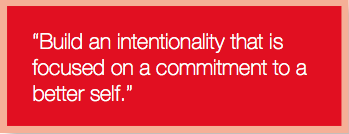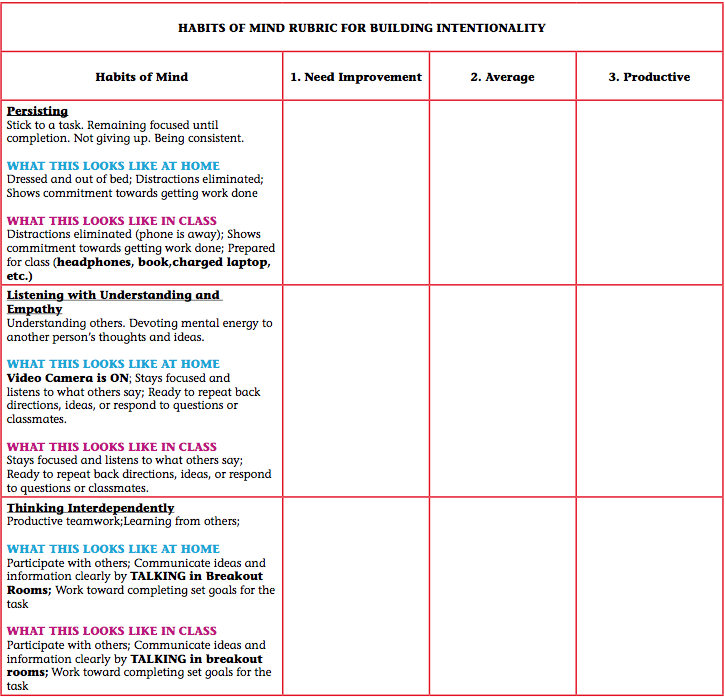Tips for Success
Hybrid learning has hit the world of education at full steam. In return, this challenge has catalysed a push for developing a new mindset: A mindset of building perseverance, commitment and interdependent thinking. Furthermore, a need for everyone to come together -to unite, listen and share their thinking. All of this while being INTENTIONAL!

Reflection
Everything seemed out of place in the first month of hybrid learning. Technical issues happened daily. Video cameras and speakers were muffled. Virtual students were showing up late to class. When they did arrive, some were still in their pyjamas. In some cases, there were instances where the bed was a learning station. And, to no surprise, within a few minutes some students were out cold. It stirred up some giggles, yet set a negative tone.
Now, we can’t forget the other side of hybrid, the brick-and-mortar learning environment. For students who were physically in my classroom, it was a constant struggle for them to come prepared. The daily grind of figuring out alternatives for headphones, computers, books and missing assignments was creating an ineffective classroom. The attention and focus to fundamental norms were quickly going out the window.
It was at this point where I needed to build intentionality, an intentionality that focused on a commitment to a better self. I figured the best approach would be to pull from the Habits of Mind. Out of all 16 habits, the ones most connected to increasing intentionality within my classroom were: persisting, listening with understanding and empathy and thinking interdependently.
Keep in mind, these three habits work best for my classroom. Your classroom may differ in the needs, actions and behaviours you want to intentionally build. So, select the ones best suited for your learners.
Habits for Intention
Intention (n): the act of commitment to carrying out an action or actions in the future. Whether at home, or in-class, the drive to be more intentional with actions and behaviours is critical. Consider how each habit works within the hybrid classroom.
Persisting: Stick to a task. Remaining focused until completion. Not giving up. Being consistent.
.
Virtual: Each student shows up to the screen ready to go. Most importantly, they must be dressed and out of bed. Being persistent with etiquette is important. Be prepared, focused and energised to learn. Designate a learning workstation. Eliminate all distractions.
In-Class: Everyone enters class ready to go. Cell phones away. Laptops open. Supplies for the class out and ready to go. Be patient and flexible throughout class – it is always important to give your virtual peers an equal opportunity to learn alongside you.
Listening with Understanding and Empathy: Understanding others. Devoting mental energy to another person’s thoughts and ideas.
Virtual: Keep the volume on screen best fit for your comfort level. Listen to your peers. Identify their feelings, thoughts and ideas. Let them know they are heard and respect their points of view. Additionally, share and demonstrate that you understand directions, content and questions posed during class. Be ready to repeat back information at any time – this should keep you on your toes.
In-Class: Listen to your on-line peers with intent. Focus attention to classmates ideas and thoughts. Block out extra distracting noise in the room. Use your listening skills to offer ideas and clarification in regard to content. Accept the challenge of repeating back directions, ideas and information.
Thinking Interdependently: Work together productively. Learning from others. Practice teamwork.
Virtual: Approach the virtual classroom with an interactive attitude. Stay on screen while maintaining eye contact with
your peers. In break out rooms, keep the conversation focused
on the topic. Keep the teamwork mindset in place. Consider the importance of sharing your screen with the group via taking notes and typing out ideas.
In-Class: Keep an open mind to working with peers in the classroom and virtually. Find an area within the room that offers you and your group an opportunity to be productive. Keep notes and write down ideas in order to be effective.
Tips to Increase Intentionality Within Students
- Allow students to create their own rules and expectations for the hybrid classroom. This strategy keeps everyone dialled into accountability, expectations and ownership.
- Offer choices in regard to brain breaks and activities for transitioning time. Give students an opportunity to come up with ideas they find empowering and engaging. Studies have shown that brain breaks reduce stress and increase attention and productivity.
- Select hybrid leaders for each class. For example, a leader from a virtual and in-class environment. These two learning leaders can offer support through taking notes, directing participation and building motivation with all students.
- Create and post a schedule before the start of class including breaks and transitions. When students are able mentally prepare before learning, the more intentionally focused they become.
• Provide a 3-minute build-in before and after every class. This is a time where students reflect, share plans for the weekend, ask questions, organise themselves, or simply just catch up with one another.

